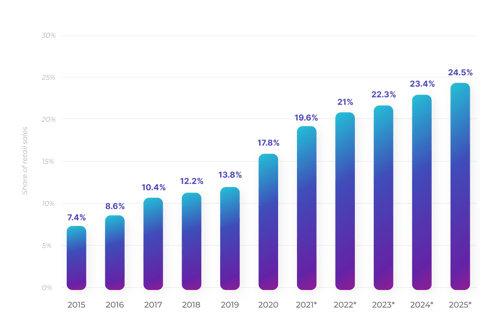The Augmented Reality (AR) space is booming. AR technology has become ubiquitous, playing an increasingly important role within people’s everyday lives. In fact, it is predicted that by 2025, 75% of the global population will be frequent AR users. This increased AR usage can be seen in dollar terms with the global market revenue for AR in 2022 being forecasted at $12.85 billion—a number that is projected to double by 2025.
AR advertising has been one of the key contributors to this growth. You only have to go back a few years to a time where AR advertising was very rare, being used as a fun novelty solely by brands with budgets that would allow them to experiment with an emerging technology. However, AR ads have now become increasingly accessible with leading digital platforms such as Meta and Snapchat each offering off-the-shelf AR solutions that can be utilized by brands of all sizes.
Along with this democratization of AR, we are also seeing the formats evolve in terms of functionality. One of the main areas where this functionality is making a significant impact is in e-commerce—with brands utilizing AR to create richer online shopping experiences for their customers. This article explores this rising utility of AR in e-commerce, explaining why it’s proven to be such a useful tool and the benefit it is having for both sellers and consumers.
Fast-tracked e-commerce growth is leading to more investment in AR
As a result of the pandemic, e-commerce spending has accelerated at an unprecedented rate. The significance of this increase can be seen in the graph below, with the 14% e-commerce share of total retail sales in 2019 seeing a steep climb to 18% in 2020.
E-commerce share of total global retail sales
 Source: Statista
Source: Statista
This greater level of e-commerce activity is causing brands to focus more heavily on creating better online shopping experiences for their customers. According to McKinsey, this will be “imperative” for brands wishing to stay relevant and competitive as shopping becomes increasingly digital.
This is why AR adoption is growing. Brands are turning to AR technology and AR advertising to play essential roles in their digital store-fronts.
What makes AR an effective e-commerce tool?
Although e-commerce popularity is on the rise and shows no sign of slowing, there are a number of drawbacks to the online experience when compared to in-store shopping.
In fact, even with the convenience and price competitiveness that is offered by online shopping, almost half (48.2%) of consumers in 2021 reported that they still prefer to shop in physical stores—citing better customer experience and the ability to see, touch and try products before purchasing as the reasoning for their preference.
With AR, e-commerce sellers finally have a viable remedy to these drawbacks as it is enabling them to replicate certain desirable aspects of the in-store experience such as the ability to digitally try-before-you-buy as well as inspecting a product in greater depth.
1. Try-before-you-buy
Perhaps the most obvious drawbacks of shopping online is the inability to try products before buying them. This leads to lower purchase confidence and higher return rates—something that is undesirable for both sellers and customers.
With AR, sellers can offer shoppers the ability to digitally try-on products before buying them. This is something that has already become highly popular within the fashion and cosmetics industries with the development of “Try-On” AR experiences.
AR can also allow shoppers to try products in ways that aren't even possible in-store. For example, hair-dye AR experiences where users can instantly change their hair colour or furniture 3D models that enable shoppers to see what things would look like in their own home. The digital nature of AR opens up many new exciting possibilities that cannot be achieved within physical stores.
2. Exploring products in greater depth
The other common drawback of the online shopping experience is the intangibility of the products people are seeing on their screen. This can make it difficult to explore the characteristics or assess the quality of a product.
This is especially a concern in the case of higher-involvement purchase decisions where shoppers want to have deep knowledge of the product before buying.
For example, you may be hesitant towards buying a bicycle online due to the restrictions in terms of inspecting different features. However, with AR, although it cannot fully replace the in-person experience, it can offer the next best thing and helps to better inform your purchase.
As AR technology continues to become more sophisticated, these experiences are only going to become more life-like, narrowing the gap between in-store and online shopping in regards to the purchase-confidence they provide.
Where to start with AR?
If you’re new to AR, it may seem overwhelming as to how to get started. A great way to get started is by utilizing one of the AR solutions offered by leading digital platforms such as Meta, TikTok or Snapchat. These solutions are simple and easy, and they give you a taste of AR’s potential.
If you would like help building AR experiences for either of these platforms, please feel free to get in touch with us here at Shuttlerock. As official Creative Partners with each platform, our design teams are AR experts and can help you to get underway in no time.











.png?width=159&height=159&name=Group%201000001080%20(1).png)

